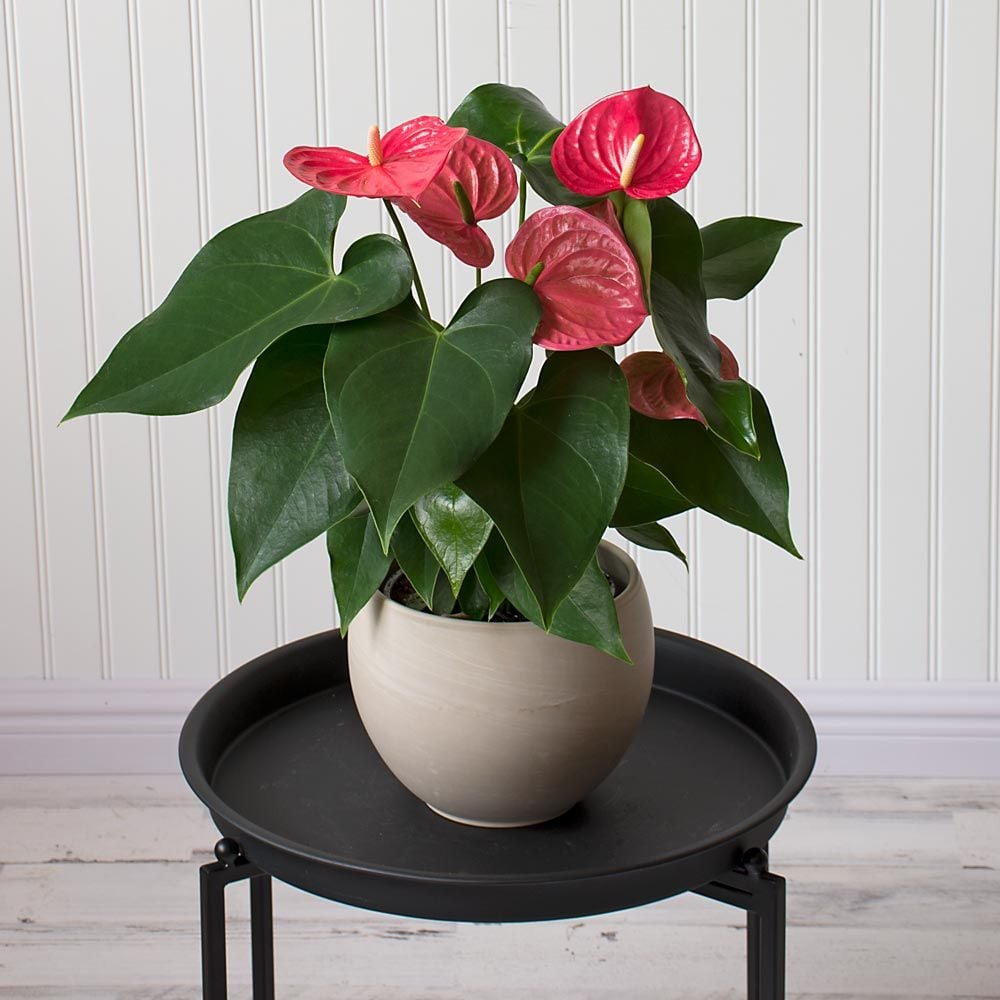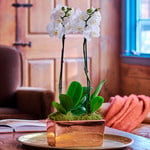Anthurium Care
Latin Name Pronunciation: an-thur-ee-um
With their distinctive outsized glossy green foliage and brightly colored flowers, Anthuriums make a bold statement in any interior space and provide year-round or seasonal interest on patios when temperatures are to their liking. Native to mountain forests in tropical North and South America, Anthuriums, also commonly called Flamingo Flowers or Laceleaf plants, come from the same family as other favorite foliage plants including Caladium and Colocasia (Elephant's Ear). Anthuriums are relatively easy to care for and are commonly grown indoors, though they can be grown outdoors year-round in shady gardens in warm regions of the country: Zone 11 or 12.
Light/Watering:
- Anthuriums grow well in bright, indirect light. Indoors, east-facing windows are generally ideal.
- Avoid direct light, which can burn the leaves of Anthurium. Alternatively, too little light can slow growth and inhibit flowering.
- Anthuriums don’t like continual moisture—allow soil to dry completely between waterings
- Water moderately during the warmer season so the soil is moist but not wet. Water less frequently in winter.
- If an Anthurium is grown indoors and the root ball becomes too dry, watering can be difficult. To remedy the problem, soak the entire pot in water for an hour to rehydrate.
Fertilizer/Soil and pH:
- Plant your Anthurium in a well-drained potting mix.
- When grown as a houseplant, an Orchid mix or a 50/50 blend of potting soil and perlite is ideal.
- If grown outdoors, Anthuriums prefer areas with well-draining soil.
- Apply a balanced, water-soluble fertilizer monthly during the growing season (April to August).
Pruning/Repotting:
- Splitting: While repotting, carefully divide the root ball, then re-plant in two separate pots with appropriate soil mixture.
- Propagating: Take stem cuttings with two or more nodes. Root cuttings in water or perlite, or plant directly in potting mixture.
Splitting/Propagating:
- Splitting: While repotting, carefully divide the root ball, then re-plant in two separate pots with appropriate soil mixture.
- Propagating: Take stem cuttings with two or more nodes. Root cuttings in water or perlite, or plant directly in potting mixture.
Calendar of Care
Spring
- Fertilize your Anthurium plant every other week with ¼ diluted liquid houseplant fertilizer
- Water regularly, when top layer of soil is dry (about twice/week)
- Repot if roots are outgrowing current pot
Summer
- Fertilize every other week with ¼ diluted liquid houseplant fertilizer
- Water regularly, when top layer of soil is dry (about twice/week)
Autumn
- Water sporadically, about once per week
- Prune faded flowers as needed
Winter
- Water sporadically, about once per week
- Prune faded flowers as needed
Frequently Asked Questions
How to care for Anthurium?
Anthurium care is relatively easy once you get the right soil and light conditions. Caring for Anthuriums indoors requires a bright spot with indirect light, well-drained soil, and weekly watering. Fertilize regularly during spring and summer to encourage growth and blooms.
Is Anthurium toxic?
Yes, Anthurium is toxic to cats, dogs, and humans. If you live in a home with children or pets, it is best to keep your Anthurium up high out of reach. When working with your Anthurium to repot, cut, or divide the plant, we recommend wearing gloves to avoid the potential for skin irritation.
How to propagate Anthurium?
Anthurium can be propagated via cuttings or splitting. If your Anthurium is quite large, you can carefully divide the root ball when repotting. Anthurium can also be grown from cuttings wherever at least two nodes are present—one to develop into roots and the other into leaves. Sanitize your shears and carefully cut a piece of Anthurium stalk. You may start the stalk in water until roots begin to form or plant it directly in a potting medium.
What does an overwatered Anthurium look like?
An overwatered Anthurium will have browning leaves and tips. Flowers may become brown as well. If this is the case, ensure that your Anthurium has proper drainage and always confirm that the top 1” of soil is completely dry before watering. Note that Anthuriums require less frequent watering in the winter when they are not growing, though they prefer a humid environment.
What should I do if the leaves of my Anthurium become discolored?
Brown leaves are an indicator of incorrect watering for Anthurium. The signal could mean you are either over- or under-watering. Always check the soil before watering: if the top 1” is dry and crumbly, it is safe to water. Otherwise, wait a few days and check again. Ensure that your pot has adequate drainage and never allow the pot to sit in water as Anthuriums are highly susceptible to root rot.
If the leaves of your Anthurium are yellow, this generally means the plant is getting too much sunlight. Move your Anthurium to a spot away from direct sunlight. These plants thrive in bright indirect light.
Why isn’t my Anthurium flowering?
Anthurium will usually produce flowers year-round. If your Anthurium is generally healthy but is slow to grow or not producing flowers, it may need more light (see Light/Watering recommendations above). An east-facing window is ideal, if available, or a location with bright indirect light. Anthurium also benefits from regular fertilizing in the spring and summer to encourage growth and blooms.






